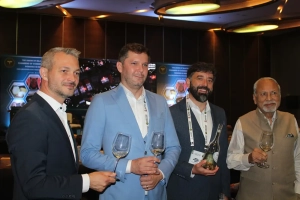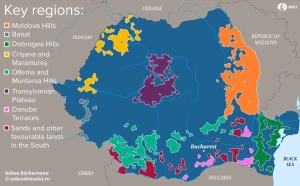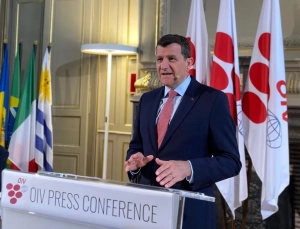From Archives (2006): IFE-2006 – Robert Joseph decries French influence in Indian wine making

Posted: Sunday, 11 December 2022 09:38
From Archives (2006): IFE-2006 – Robert Joseph decries French influence in Indian wine making
Robert had taken the opportunity to visit Sula winery at Nashik and taste some of the wines being produced there. He also met Kapil Grover in Bangalore before coming to Delhi.
His first impression was that there were too many people in the business for wrong reasons. ‘True, Rajeev (Samant) and Kapil (Grover) have other businesses. In fact, it is very important to have a flourishing business that can support you when the wine business is not doing well for whatever reasons. But they are totally into wine production and are passionate about their wines. But Renaissance Winery has a petrol pump business and wine making as a side business. It is not easy for such people to make good wine,’ he opined.
French style does not suit Indian wine production techniques, he added. There is general lack of ripeness in red wines. France has a history of making wines from unripe grapes. Michel Rolland wants to have the grapes ripened and that is why he is considered sometimes, aping the New World style.
‘Jacquinot, who is wine maker for ND Wines and now also for Seagram’s, is a great sparkling wine maker. But there is no evidence of his being a red wine maker. These red wines won’t cut it for the UK market. I am frankly, disappointed both by ND and Nine Hills wines.’ Incidentally, ND Wines make wines from their own grapes while Seagram’s is sourcing them from contracted farmers.
So which are the wines he liked? ‘I liked Sula’s Sauvignon Blanc. Less said about Chenin Blanc, the better. Dindori is a nice wine but nothing great about it. What I really liked was La Reserve from Grover. At Rs.440 the wine is definitely under-priced I feel. I am not sure if Dindori is worth Rs.650’, he added. ‘I won’t rate Vinsura high. I haven’t tasted other wines from Champagne Indage but their Marquise de Pompadour used to be good: not anymore.’ ‘I would have liked to taste wines from Vintage Wines, which I believe are premium wines selling at 750, 800 and even Rs. 1500,’ he added.
He showed a lot of concern over wine lying stored in S.S. tanks in Nashik. ‘Too much of 2005 white wine is lying in the tanks at the moment in India ‘. ‘It would lose its freshness if it lies for much longer period’, he commented. He also expressed surprise on the popularity of Red wine in India and the obsession of Indian producers to go for red wines so seriously. ‘ India is a warm country. People should be drinking more of white wines-it is only right for your climate,’ he added.
Of the wine personalities he felt ‘Rajeev will be a big star. He looks like the Yellow Tail story at the moment’. Yellow Tails is the biggest selling brand in the US , perhaps the whole world. It is owned by Bill Deutsch who made Georges Duboeuf popular in the US . Despite a slump in the Australian wine export, the sales grew at 18% last year in the US . It is being imported in India by Sonarys of Mumbai. ‘Kapil is more intelligent wine producer. I would be happier being in Bangalore .’
Robert does not support having too many laws for winemaking. ‘New world does not have any laws on yields. Nashik may give a yield of 10 tonnes of grapes per acre instead of 5or 8. But we can taste and tell if it is higher yield. The market forces should decide the quality/price equation. For instance, to be told by the government as it does in Bordeaux which day to start the harvest is not right. The farmer should be able to decide that. Similarly when and how much to irrigate should be the grower’s choice. At the end of the day, his quality of wine will be judged by the experts and the market only. Even Italy had to evolve the IGT appellation to give the farmers liberty of taking relevant decisions’, he suggests





“16 years seems like a very long time ago. In fact, my daughter is 16 and my son just 18 months older. When you and I had that conversation, Subhash, I had no way of imagining that I would one day see my Le Grand Noirwines earning their place among the most popular in India. I really appreciate the friendly support you have given me over the years, and all the invaluable information you have shared with everybody about the complexities of the Indian wine market.
Your dusting-off of my thoughts in 2006 is quite timely, because I’m currently going through things I have written and said since the 1980s for a book to be published next year.
For better or worse, I have always tried to ask questions even when they may have struck the recipient as impertinent, and attempted to make sense of the answers and if and how they fitted into what I had seen, heard and tasted with my own senses.
Often, of course, I’ve inevitably got it wrong, but those occasions can be just as interesting and instructive as the ones that allow me to pat myself on the back for having backed the right horse or foreseen a storm others had overlooked.
For many years, as wine exports to China boomed and other markets ranging from Vietnam to Russia showed ever more promise, India continued to look like the most laggardly runner in the race. The quality of Indian wine seemed to evolve frustratingly slowly too, and Grover – before it became Zampa-Grover – failed to blossom as much as I certainly had hoped.
But, as everyone knows from the fable about the tortoise and the hare, it isn’t always the rapid starter that wins the race. Chinese consumers still drink far more than their Indian counterparts but, as I recently noted in Meininger’s, since 2018, they have been cutting back. Today, China’s wine consumption is at a 20-year low and, following the imposition of draconian tariffs on their wines by Beijing, Australian producers who were relying on the Chinese market are now desperately looking elsewhere.
Meanwhile, as I’ve been delighted to see, a new generation of Indians – especially young women – are discovering wine and increasingly embracing it far more eagerly than their parents. Gratifyingly, the quality of Indian wine is improving too. Producers such as KRSMA, Fratelli, York, Charosa, Reveilo and Sula, of course, are all making really impressive wines, and – as I hoped 16 years ago – moving beyond the early focus on Cabernet Sauvignon and Chenin Blanc.
I’m very excited to see how the Indian wine story unfolds and look forward to witnessing it for myself – with a bit of help from Subhash, of course.”